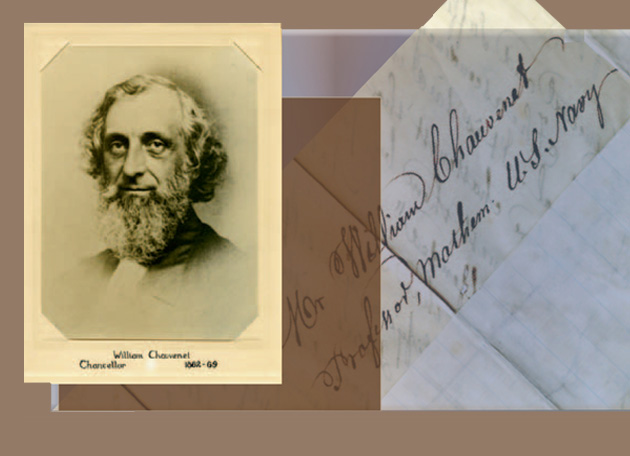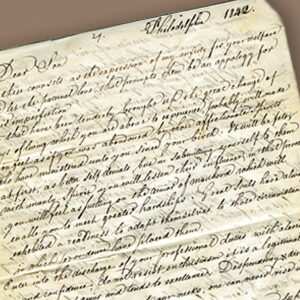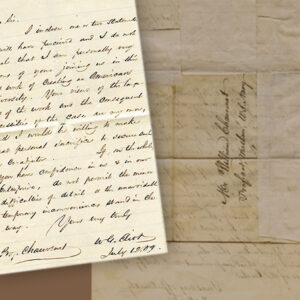
Early in 2008, amid the myriad items posted each day on eBay, one tantalizing piece popped up: a letter from mathematician and astronomer William Chauvenet (1820–70), who joined the Washington University faculty in 1859. The next day came a second, then a third — and soon 16 complete and two partial letters were for sale. It was a breathtaking collection of correspondence to and from Chauvenet, who served as the university’s second chancellor from 1862 to 1869.
But there were questions. Were these letters, which span the period 1842 to 1868, authentic? (Yes, they were.) Where did they come from? (A part-time student, who paid for his education by selling items on eBay, had found them at a house sale in Albuquerque, N.M. The family, no longer interested, was disposing of them.)
For close to $3,000, the university acquired the entire group — and, in the process, gained a vastly improved understanding of the brilliant Chauvenet, who left an international legacy. The Mathematical Association of America awards the prestigious Chauvenet prize each year (twice so far to Washington University professors); the U.S. Naval Academy, where Chauvenet taught, named a building for him; and the U.S. Navy has called two ships Chauvenet.
He also made one important, but little heralded, contribution to St. Louis: mathematically confirming plans for the Eads Bridge across the Mississippi. On the Washington University campus are some Chauvenet mementoes. A bronze plaque hangs in the arcade outside Ridgley Hall, while two visiting professorships in the Department of Mathematics in Arts & Sciences are named in his honor.
Competing For His Talents
From existing letters and records, Washington University already had some information about Chauvenet. The only son of a prosperous French émigré, he graduated from Yale University in mathematics and classics before accepting a faculty job with the U.S. Navy in 1841. At first, he taught midshipmen at sea, but then he moved to the Philadelphia Naval Asylum School. Subsequently, he helped persuade Congress to move the school to Annapolis, re-christen it the U.S. Naval Academy, and extend its course of study to four years.
His faculty colleagues deeply admired him — and felt a little awestruck in his presence. Sylvester Waterhouse, a classics professor, said of him: “Mr. Chauvenet moved with the ease of genius in the higher walks of mathematical science.”
When Chauvenet entered the job market in 1859, he was much in demand. Both Washington University and Yale University pulled out all the stops to attract him. But Washington University won, and only three years later, when Chancellor Joseph Hoyt died of tuberculosis, the board turned to Chauvenet to become the university’s second chancellor.
He attacked the job with vigor: presiding over the start of a new law school, building up the student body, and hiring (or firing) faculty members — with sometimes caustic candor. He dismissed one writing professor, Etienne Boileau, by writing: “Indeed so unfortunate is Mr. Boileau in the matter of discipline that even if we were compelled to admit the instruction in his branch … I should think it necessary that his services be dispensed with.”
His faculty colleagues deeply admired him — and felt a little awestruck in his presence. Sylvester Waterhouse, a classics professor, said of him: “Mr. Chauvenet moved with the ease of genius in the higher walks of mathematical science.” After his death, William Greenleaf Eliot, then Washington University’s board president, called him “one of nature’s noblemen. … His name conferred early distinction upon this University.”
Adding to the portrait
The new collection illuminates every phase of his life: from his early naval duties through his struggle to survive the lung ailment that eventually claimed his life. A number of letters are addressed to his wife, Catherine “Kate” Hemple Chauvenet, whom he had married in 1841. Eventually, they had six children: Their daughter attended Mary Institute and several sons graduated from Washington University.
Earliest of all is an 1842 coming-of-age letter written by Chauvenet’s father, living near Philadelphia, to his son, then embarking on a Navy ship to teach mathematics. Writes the elder Chauvenet in a graceful, European-style script: “To you that have been tenderly brought up, the great change of ways of living which you are about to experience probably will make you feel as if you was [sic] abandoned by those affectionate Spirits who have ministered unto you since your birth.”
Yet despite the “bitter self-denials” that he would have to make, added his father, William should put on “the armor of manhood which will enable you to meet greater hardships.” With his new charges, he should use “persuasive mildness and sociability” to win them over. Most of all, “in foreign lands, have pride of doing or saying anything that reflects honor upon the American nation.”
Apparently, Chauvenet did feel abandoned. In a letter to Kate, written aboard the USS Mississippi, he complained of haughty disregard by the captain — whom Chauvenet sardonically called “this quintessence of captainship.” Further, he said, the man was widely regarded to be dim-witted:
“It is told as a fact that he read The Arabian Nights once upon a time, and when he had read nearly to the end of the third volume, he suddenly threw the book down and exclaimed: ‘D— it, I believe it’s a lie!’ This may or may not be true, but I assure you I have every reason for considering it an excellent illustration of his intellectual discernment!”
Still, Chauvenet made a success of his naval career. By 1850, he and his wife were living in Annapolis with their growing family, when another letter arrived from his father. Amid chitchat about the flooding of the Schuylkill River, he slipped in proudly that a friend’s son was just purchasing Chauvenet’s Trigonometry for his high school class.
Then in 1859, a colleague of Chauvenet received an inquiry from an acquaintance, Joseph Reynolds of St. Louis, who was teaching at Washington University. The school needed a math professor and could offer $2,500 a year. Would Chauvenet be interested? Apparently, the answer was “maybe,” because a flurry of correspondence ensued.
In June, Eliot wrote, urging Chauvenet to take the job. “We hope that … we shall like each other so well as never to part. You will find us young and immature but hopeful and vigorous.”
In June, Eliot wrote, urging Chauvenet to take the job. “We hope that … we shall like each other so well as never to part. You will find us young and immature but hopeful and vigorous.” Only a day later — in a well-orchestrated one-two punch — the recently appointed Chancellor Joseph Hoyt applied more blandishment. “I think of nothing now in ‘the wicked world’ which would give me so much pleasure as your acceptance of the Professorship tendered to you.”
So Chauvenet came to see for himself — and, after a visit to the country estate of eminent physician Charles Pope, described the burgeoning city in an effusive letter to Kate:
“Dr. Pope (the Pope of Rome is nothing to him) took me [on] a beautiful drive into the country. … I cannot begin to tell you what I saw on the drive: A new country, just cleared, being taken up day after day with the most wonderful speed. … It stirs one up to see this city grow — for I see it grow while I am here. … The University is all future and yet perhaps as certain a future as the city itself.”
Wined and dined by university leaders, Chauvenet seemed ready to commit — but a counter-proposal arrived in a letter from Benjamin Silliman, illustrious Yale University chemist. Also a father of six, Silliman argued that Chauvenet’s children would be better served by New Haven schools. “It is almost impossible to bring up boys in any large western city with pure morals — the youth there are far more commonly profane, lewd and fast-living.”
But letters from Eliot followed Chauvenet home. “I am personally very desirous of your joining us in the great work of creating an American University. Your views of the largeness of the work … are my own, and I would be willing to make great personal sacrifices to secure such a Co-adjutor.”
Join he did — and 1860s-era letters to the university’s board trace his record through the tumult of the Civil War (three students “left us … for the purpose of joining the rebel army”). By 1866, he could boast “that St. Louis possesses a body of students who have been or are being educated up to a point they would not have thought of reaching, or would not have cared to reach, but for the influence of the University.”
But Chauvenet’s last letters, written to Kate in 1869, describe — with poignant optimism — a western trip that he hopes will restore his health. “I am able to bear much more fatigue than when I started,” he says. Sadly, he died the next year. But at least we now have these revealing letters that add to our understanding of his accomplished, too-brief, life.
Candace O’Connor is an award-winning freelance writer based in St. Louis.


Comments and respectful dialogue are encouraged, but content will be moderated. Please, no personal attacks, obscenity or profanity, selling of commercial products, or endorsements of political candidates or positions. We reserve the right to remove any inappropriate comments. We also cannot address individual medical concerns or provide medical advice in this forum.